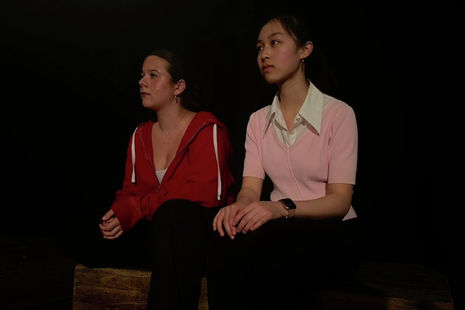Mind: The Gap is intensely creative
Bethinn Feely is strongly compelled by this student-written psychological study

Whilst the audience slowly filed into the small room of the Pembroke cellars for the first staging of writer and director Lilly Sneddon’s Mind: The Gap their murmured discussions were undercut by an eerie mix of low undulating tones, the sound of trains speeding off from a station, and a high-pitched violin. This created a harsh soundscape that formed a feeling of unease and tension associated with the train before the play had even begun.
Set largely in a train carriage, the play’s drama occurs predominantly in the minds of the only two ‘real’ characters Niamh (Lily Sneddon) and Murph (Tahmid Azam) as they come to terms with the ostensibly accidental death of their friend in a car crash.
Mind: The Gap is undoubtedly intensely creative in its setting and the fact that most characters on stage are not real but figments of Niamh and Murph’s splintered minds. This creates a claustrophobic atmosphere as the audience becomes maddeningly trapped in the minds of Niamh and Murph while they grapple with the tragedy that befell their friend.
“The audience becomes maddeningly trapped in the minds of Niamh and Murph while they grapple with the tragedy that befell their friend”
Generally, the performances were strong despite some small slip-ups in dialogue which can be attributed to opening night nerves. Two stand-out performances were those of Azam, who managed to interweave Murph’s emotional woes with panicked desperation, and Henry Davies, who captured the erratic frustration and annoyed sarcasm of Frank – Murph’s internal monologue. The dialogue here feels natural and quick-witted through elements of subtle humour such as in Murph’s request to Frank “Can you not pace like that” and Frank’s sarcastic reply “How else would you like me to pace?”.
Sneddon’s staging is also particularly effective. Wooden boxes are placed at one end of the room, laid out like seats with two taller boxes behind two smaller ones. A gap between the two sets visually repeats the gap between the train and the platform, metaphorically alluding to the gap in Murph’ memory of the night of the crash.
This set-up encourages the dynamic movement of all the actors, a particular strength of the play. Krystyna Lazaro’s (playing Vil – the physical embodiment of Niamh’s internal monologue) swift movement between standing on the tallest box to sitting on the floor with her arms wrapped around her knees hints at Niamh’s unsettled emotional state. The use of the higher row of boxes as the place where the ‘inner monologue’ characters sit is a particularly clever staging to indicate the power of the voices over Murph and Niamh.
However, the play did sometimes seem to suffer due to the breadth of themes and extreme changes in characterisation that it tried to include in an hour-long play.
“Sneddon holds a warped mirror up to her audience asking us to consider the gaps of shame and guilt we choose to step over and ignore in our own minds”
For example, though we are told that Niamh was ostracised by the group before the crash, to the point that it felt like a “death” to her, we never see this dynamic played out between Niamh and Murph. It is also mentioned only in passing in Niamh’s opening dialogue and therefore feels like a very sudden, unearned explanation for Niamh’s actions at the end of the play. Similarly, elements of Murph’s characterisation feel rushed also, such as his regaining some memories of the crash in the final scene. I felt this was under emphasised as it is only mentioned by Azam in a calm tone which perhaps contradicts the pain, we have seen this loss of memory cause to Murph throughout the play.
Moreover, director Lily said in a conversation with me after the show that Mind: The Gap focuses on how “bad choices can have good motivations”. However, this idea seems slightly forced into the play, especially in comparison to the stronger metaphor of the ‘gap’ between platform and train to represent the gap in Murph’s memory. It is not always clear how exactly Murph could make ‘good decisions’ in a situation where he is so powerless, whilst the idea of ‘getting off at the correct train stop’ and not letting the train ‘run to the end of the line’ seems to metaphorically contradict Murph’s pursuit of truth – which he does take to the end of the line. Rather, Murph becoming “lost” in the ‘gaps’ in his memory, I feel, is a far neater metaphor, emphasised by the play’s rumination on Murph’s emotional suffering and guilt from his inability to remember the crash.
However, the play remains particularly successful in the “embellishment of the role of asides” – as director/ writer Lily described the play, which lends itself to focusing on the complications and self-doubt that can occur within the mind. a particularly important focus for the play as 50% of the profits are going to the charity Headway and Mind. Though I feel that Sneddon’s attempt to focus on unintentionally bad decisions is less clearly communicated this does not undermine the power of the play’s psychological analysis of Murph and Niamh. Any loud noise caused the audience to jump. We were all so engrossed by the intense delve into the gaps of shame, fear and guilt in Murph’s mind. Sneddon holds a warped mirror up to her audience asking us to consider the gaps of shame and guilt we choose to step over and ignore in our own minds.
 News / Cambridge academics stand out in King’s 2026 Honours List2 January 2026
News / Cambridge academics stand out in King’s 2026 Honours List2 January 2026 Interviews / You don’t need to peak at Cambridge, says Robin Harding31 December 2025
Interviews / You don’t need to peak at Cambridge, says Robin Harding31 December 2025 Comment / What happened to men at Cambridge?31 December 2025
Comment / What happened to men at Cambridge?31 December 2025 Features / “It’s a momentary expression of rage”: reforming democracy from Cambridge4 January 2026
Features / “It’s a momentary expression of rage”: reforming democracy from Cambridge4 January 2026 News / Varsity’s biggest stories of 202531 December 2025
News / Varsity’s biggest stories of 202531 December 2025










